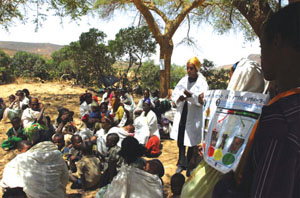9.4.2 Social mobilisation
Social mobilisation is a critical component of EOS/CHD where the community needs to get clear messages about what are the services; who will receive the services; when the service day for the community will be; where the EOS/CHD will be held for the community being mobilised (see Figure 9.5).

The opportunity is also used to increase the community awareness of the benefits of the components of EOS/CHD and also to increase demand for health services, particularly routine immunization. Community health workers play a critical role in social mobilisation. As a Health Extension Practitioner you may also disseminate the information using the kebele administration and village elders and leaders.
What is the purpose of community mobilisation?
An important purpose is to bring children to a central place so they can receive the services they need. These services will be based on eligibility criteria. It also provides parents and caregivers an opportunity to ask about any concerns they have about their children’s health.
Depending on the size of the kebele, you may subdivide your outreach into a group of villages (outreach site), and decide on a different central location for each of the grouped villages. You should organise yourself to complete the EOS/CHD for all the outreach sites within a short period of time, usually over a maximum of one week.
It is important that the community is informed of the date of the EOS/CHD in advance. Failing to complete an outreach site visit that was in your initial plan could disrupt your next outreach site visit where people will be waiting for you. Therefore, you need to make a realistic plan and stick to this as closely as you can.
9.4.1 Planning for supplies
